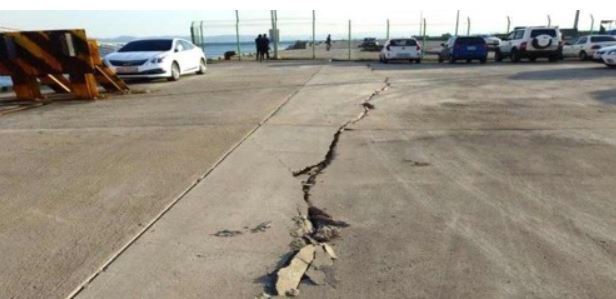Energy minister visits nuclear reactors following earthquakes
By YonhapPublished : Nov. 16, 2017 - 12:01
South Korea's energy minister visited a nuclear power plant complex on the southeastern coast Thursday to check on safety after a 5.4 magnitude earthquake hit the nearby city of Pohang the previous day, followed by a series of aftershocks through the night and into Thursday morning.
Paik Un-gyu, Minister of Trade, Industry and Energy, inspected Wolsong nuclear power complex in Gyeongju, 370 kilometers southeast of Seoul, which remains in operation after the second-strongest tremor recorded in the country rocked the region on Wednesday.
The epicenter was 45 kilometers from the complex, where six reactors and a radioactive waste disposal facility are located. Though weaker than last year's magnitude 5.8 earthquake in Gyeongju, the actual damage was much greater in Pohang, as the epicenter was closer to the surface.

During his second visit to the complex since September, Paik called on state utility companies to maintain a high alert against contingencies in the event of a strong earthquake.
The ministry has upgraded the emergency response level following the latest earthquake and kept a round-the-clock watch on major energy facilities.
Paik ordered the state-run Korea Hydro & Nuclear Power Corp. to strengthen the seismic functions of key facilities and to conduct stress tests on nuclear facilities as planned.
All of the nation's 24 reactors are operating normally, the KHNP said, noting it will conduct in-depth inspections to assess the quake's impact on major facilities.
The policymaker also visited a substation in Pohang, which is home to major companies in the steel, auto and petrochemical sectors, to check its safety. POSCO, the nation's top steelmaker, is based in Pohang.
Following the 2011 Fukushima nuclear meltdown, South Korea has been upgrading the nuclear reactors' seismic safety features to be able to withstand a magnitude 7.0 quake.
For the Shin Kori units 5 and 6 under construction in the southeastern city of Ulsan, the KHNP said they will be built to be safe against a magnitude 7.4 quake.
Experts say the Korean Peninsula is no longer a safe zone in terms of earthquakes, as recent tremors in nearby Japan could have destabilized the fault lines on the eastern coast. (Yonhap)






![[From the Scene] Monks, Buddhists hail return of remains of Buddhas](http://res.heraldm.com/phpwas/restmb_idxmake.php?idx=644&simg=/content/image/2024/04/19/20240419050617_0.jpg&u=20240419175937)





![[Graphic News] French bulldog most popular breed in US, Maltese most popular in Korea](http://res.heraldm.com/phpwas/restmb_idxmake.php?idx=644&simg=/content/image/2024/04/18/20240418050864_0.gif&u=)



![[From the Scene] Monks, Buddhists hail return of remains of Buddhas](http://res.heraldm.com/phpwas/restmb_idxmake.php?idx=652&simg=/content/image/2024/04/19/20240419050617_0.jpg&u=20240419175937)

![[KH Explains] Hyundai's full hybrid edge to pay off amid slow transition to pure EVs](http://res.heraldm.com/phpwas/restmb_idxmake.php?idx=652&simg=/content/image/2024/04/18/20240418050645_0.jpg&u=20240419100350)

![[Today’s K-pop] Illit drops debut single remix](http://res.heraldm.com/phpwas/restmb_idxmake.php?idx=642&simg=/content/image/2024/04/19/20240419050612_0.jpg&u=)